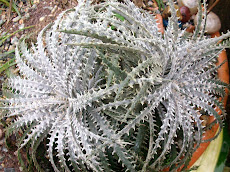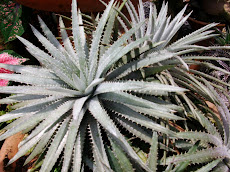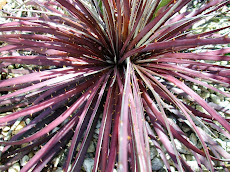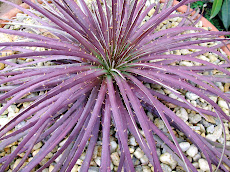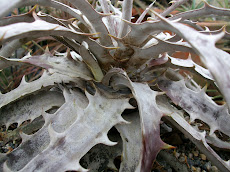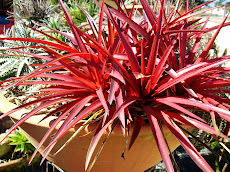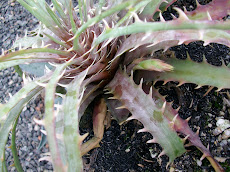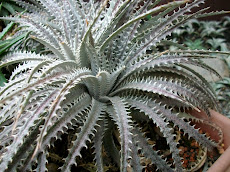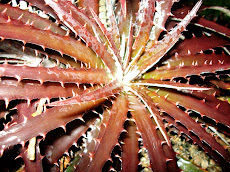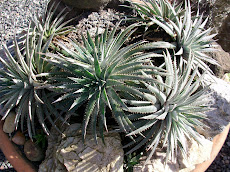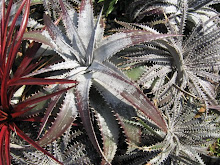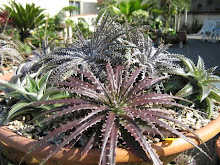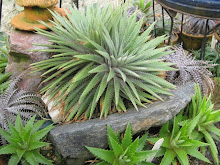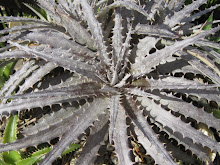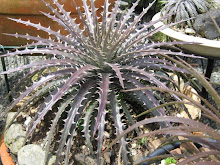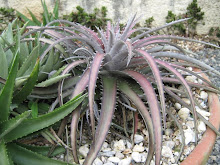Tillandsia fasciculata
...a must in any garden of beauties.Feb 28, 2010
Dyckia companion Sinningia speciosa jurapensis
Sinningia speciosa loves the very same treatment a Dyckia crave for so they are a perfect pairing.
Fascination, that is the name of the game here. These Brazilian plants allure me.
This deep red Sinningia speciosa jurapensis is a deviation of the blue wild one I brought down the Jurapê Mountain more than a decade ago. Jurapê Mountain is the highest isolated one in Joinville.
It is covered almost to the top with a luxuriant tropical forest that makes the climbing extremely difficult.
One have to carry a heavy back pack as it is impossible to come back down the mountain before the darkness of the night. You have to spend the night on top of the mountain also you will nedd a skilled guide and the health and the physique of a Spanish bull to get there.
Dyckya sp from Tabaí - Rio Grande do Sul
Some Dyckias do not ned to be silver nor red to be explendid plants.
Here Beauty comes in green a sole green dressing.
Dyckia insignis
Dyckia insignis
Flowers are a few and big. They so not open and just the sexual parts are motited through a hole.
This is to preserve the ovarium from drying. This plant lives in Paraguay in an area where the air may be excesively dry.
This plant is also a nonself fertileone.
Flowers are a few and big. They so not open and just the sexual parts are motited through a hole.
This is to preserve the ovarium from drying. This plant lives in Paraguay in an area where the air may be excesively dry.
This plant is also a nonself fertileone.
Feb 27, 2010
Dyckia Brittle Star or Bill Baker´s heartbreaker...
..and I am entirely heartbroken... shattered, smashed actually ... and whose heart could not?
A beauty like this gets my heart into pieces... scattered all around...
From Rio Grande do Sul
...and the sun was breaking through...
This beauty comes in sole greeens, all sorts of reds and silver and each one is a hearthbreaker...
What is this dust like material on the substrate?
I got questions about this material that may be visible in some pictures.
This is what we call here chicken bedding. Saw dust used in poultries to raise chicken
This saw dust is used to cover the floor. So this is saw dust plus chicken droppings,
feathers and whatever may be found there. This bedding is removed then grinded into a fine dust. This is a Nitrogen rich material, cheap and abundant in Santa Catarina as we are the largest chicken producer in the world. This nutritious fertilizer is at plenty here.
Dyckias adore it and grow rapid and strong.
Dyckia fosteriana nivosa - Lapa-PR
Nivosa or the snowy Dyckia fosteriana is a small variety of this fantastic Brazilian plant.
Rare and stunning my grandmother should had loved one on her cacti windowsill.
Feb 26, 2010
Dyckia goehringii x Dyckia pectinata
Its spines as those of Dyckia pectinata are soft rubbery.
This is a singulary beautyful hybrid Dyckia.
This is a young hybrid plant.
Controled intentional hybrids are hard to get with Dyckias and many aspects must be taken into consideration in order to be sure of what is going to come out from a crossing.
Dyckias readily and enthusiastically cross with any other Dyckia and sometimes this other one is not so close nor around.
This is a hybrid brought up from seeds from a Dyckia fosteriana Sengés flower pollinated by a Dyckia brevifolia pollen.
This is for sure a luxury.
Spines are big and by the plenty also being clear contrast well against the dark foliage.
Dyckias made a deal with the Sun. They promissed to adore this star and the Sun made sure to make them better looking each day. That is why Dyckias get prettier as they get old.
This here is a young plant, an unnamed species from Rio Grande do Sul.
...a treat from Heavens.
Dyckia sp Lagoão - RS
This plant is long known in Rio Grande do Sul and oddly enough it is undescribed up to now.
Grows on a rocky cliff East of the Small Lagoão town.
It is a very impressive plant when under water stress ´cause it gets all red and its spines get white.
Dyckia Mundo rubra form
Yes this is a hybrid, a beautiful one Dyckia Mundo rubra form.
No, it is not any red Dyckia platyphylla.
This resulted from a Dyckiamanrnier-laporollei and Dyckia brevifolia torrid affair.
Dyckias surprise me, amaze me, allure me all the time....
...the older the better. Aging just counts on their favor..the older they get the fresher they look...
Humm Ponce de Leon should have known the secret...
Dyckia went deep into the Youth Fountain....
When they flower they celebrate life and get even better looking, they do not give up life after blooming.
...Dyckias! Yes, indeed
Feb 25, 2010
Dyckia species native to Rio Grande do Sul
This beauty comes in red, red wine and green/chestnut colored forms.
The highlight here are the clear contrasting hooks.
These are juvenile young plants. Adult plants bear huge hooks bigger than the leaves are wide.
Dyckia encholirioides var.spinosissima
This is one of the most beautiful piucture on Dyckias I ever saw.
Took by a proffessional phographer Luiz Hille in Praia do Erwino - Santa Catarina.
Dyckia encholirioides var. spinosissima grows on sand and it is only found on sand.
This species stands temperatures well over 45 centigrades and below zero in Winter. The wind uses to be so strong no trees are found there. South wind may be terribly cold.
Took by a proffessional phographer Luiz Hille in Praia do Erwino - Santa Catarina.
Dyckia encholirioides var. spinosissima grows on sand and it is only found on sand.
This species stands temperatures well over 45 centigrades and below zero in Winter. The wind uses to be so strong no trees are found there. South wind may be terribly cold.
Minas Gerais wilderness reveals one more beauty, this time a top mountain dweller Dyckia
The Brazilian wilderness has much to be known, no doubt but each day the mountains get higher to climb as those species easy to get are almost all known, described and published.
This here is a new finding from a mountain top in Minas Gerais.
Dyckia species from Minas Gerais - Brazil
If this beauty already has a name I do not know it.
One thing I know for sure: this is a Dyckia species and comes from Minas Gerais
Feb 24, 2010
Dyckia speciosa from Santa Catarina
Dyckia speciosa
When color is plentyful
The intense silver coating on the leaves reverse is a noticiable contrasting color.
Dyckia minarum - Santa Catarina form
Dyckia minarum - Santa Catarina form
Native to the most extreme North area of Santa Catarina, The Quiririm.
There we have temperatures below freezing almost every night in Winter. It is a huge plato where no human being lives. The area is protected ´cause there the river that supplies Joinville, the biggest city in Santa Catarina, with pure good water begins up there.
Subscribe to:
Posts (Atom)




















































